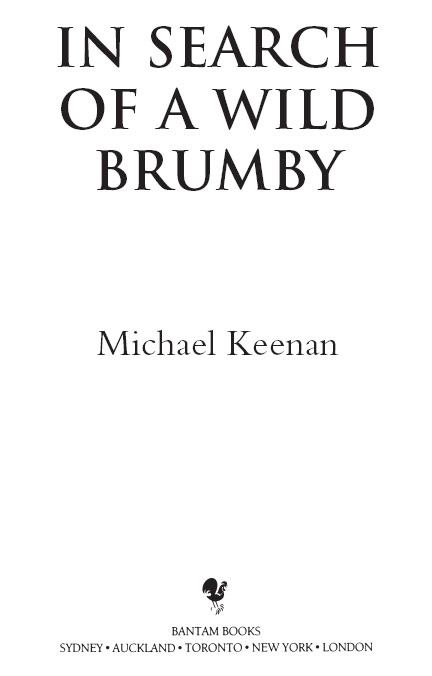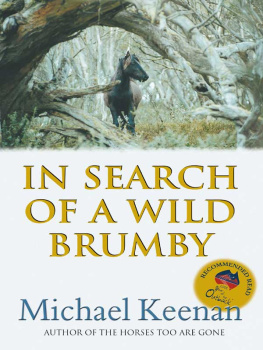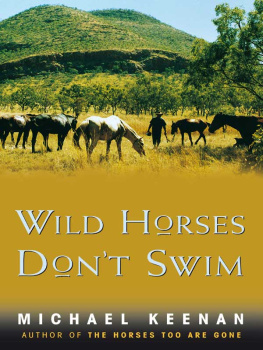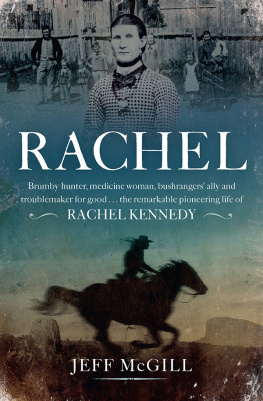Also by Michael Keenan:
The Horses Too Are Gone
Wild Horses Dont Swim

All rights reserved. No part of this book may be reproduced or transmitted by any person or entity, including internet search engines or retailers, in any form or by any means, electronic or mechanical, including printing, photocopying (except under the statutory exceptions provisions of the Australian Copyright Act 1968 ), recording, scanning or by any information storage and retrieval system without the prior written permission of Random House Australia. Any unauthorised distribution or use of this text may be a direct infringement of the authors and publishers rights and those responsible may be liable in law accordingly.
In Search Of A Wild Brumby
ePub ISBN 9781742742847
Kindle ISBN 9781742742854
Note : The names of some people in this book have been changed.
IN SEARCH OF A WILD BRUMBY
A BANTAM BOOK
First published in Australia and New Zealand in 2002
by Bantam
Copyright Michael Keenan, 2002
All rights reserved. No part of this publication may be reproduced, stored in a retrieval system, transmitted in any form or by any means, electronic, mechanical, photocopying, recording or otherwise, without the prior written permission of the publisher.
National Library of Australia
Cataloguing-in-Publication Entry
Keenan, Michael, 1943-.
In search of a wild brumby.
ISBN 978 1 86325 319 2
ISBN 1 86325 319 X
1. Wild horses - New South Wales - Snowy Mountains Region. 2. Adventure and adventurers - New South Wales - Snowy Mountains. I. Title.
636.100994
Transworld Publishers,
a division of Random House Australia Pty Ltd
Level 3, 100 Pacific Highway, North Sydney, NSW 2060
http://www.randomhouse.com.au
Random House New Zealand Limited 18
Poland Road, Glenfield, Auckland
Transworld Publishers,
a division of The Random House Group Ltd
61-63 Uxbridge Road, London W5 5SA
Random House Inc
1540 Broadway, New York, New York 10036
Internal photos by Mike and Sally Keenan, except where indicated otherwise.

In the big picture of an environment under siege from toxic rivers to land clearing on a frightening scale in Queensland the brumby debate may seem a very minor issue. Yet the anti-brumby lobby has aroused distrust and sometimes hatred in already stressed rural communities, which in turn can create the potential for a weakening in resolve on the need for sound and urgent environmental reform.
I am an active supporter of the establishment and maintenance of wilderness areas where any attempt at land usage would result in irreparable destruction indeed, in 1993 I donated 50 hectares of old growth forest to the Gardens of Stone National Park. All land is unforgiving, and farmers who deploy poor management practices are soon shown the gate. Its not a bad lesson for the whole Australian community.
Michael Keenan
Contents
There was movement at the station, for the word had passed around
That the colt from old Regret had got away,
And had joined the wild bush horses he was worth a thousand pound,
So all the cracks had gathered to the fray.
All the tried and noted riders from the stations near and far
Had mustered at the homestead overnight,
For the bushmen love hard riding where the wild bush horses are,
And the stock-horse snuffs the battle with delight.
from The Man from Snowy River, A. B. Banjo Paterson

Principal brumby populations in Australias southeastern ranges

And upward, ever upward, the wild horses held their way,
Where mountain ash and kurrajong grew wide
In the Northern Territory I have seen them in the stifling savannah woodlands of the Top End. I have seen them when the mist parts and rises in the waterfall country of the northern tablelands in NSW and I have chased them and crashed heavily into the snow on the high plains of Victorias alpine zone. Only in the arid desert regions of Australia might I be disappointed if I sought them brumbies.
No one knows for certain when wild horses became known as brumbies in Australia. A popular story is that the term originated with a Major Brumby whose horses were said to have escaped into the wild or been abandoned, but I think its possible that brumby was an Aboriginal term for wild horse.
Nationwide, brumbies have been part of our folklore since the mid-19th century. They have always been regarded ambivalently. Like so many other introduced animals running in a wild state, wild horses have become a pest in some regions. Debates over whether they should be culled or not relate mainly to issues of animal welfare, not so much a desire for wild mobs to run free. But lurking beneath this debate is the extraordinary bond between horse and man.
At some point in time we moved beyond the predator prey relationship. We started riding them, probably for speed to hunt other animals. French archaeologists have discovered horse molars in caves with bridle-bit wear, dating back 15 000 years. This discovery suggests that ancient European societies have evolved since the late Pleistocene with the practical help of horses. This is a bond between man and animal that has no parallel. If culture is the product of learning over many centuries, then the fate of horses in modern times must surely awake an old spirit inside us. It is little wonder that there is conflict over what to do with brumbies in the regions where the folklore is best remembered.
Brumby running is a Snowy Mountains tradition which began with the second generation of squatters, in the 1850s. Nowhere else in the world do men gallop after wild horses and catch them with a lasso. American cowboys muster mustangs to corrals and do far more calf roping from horseback than is done in Australia, but they dont lasso mustangs at full gallop in the wide open spaces.
Just what prompted the Australian enthusiasm for such a dangerous activity is anybodys guess, but I have a theory that goes back to early settlement on the Monaro. On the high plains around the central town of Cooma, the early settlers did it tough. It was nothing to do with the soil. Long-extinct volcanoes spewed rich layers of basaltic material over thousands of hectares which weathered into an undulating, fertile landscape. Some of the early settlers were Scottish and not to be daunted by the long bleak winters. What they may not have bargained for was the Monaro rain-shadow and the frequent dry spells. Frontal bearing clouds slam into the alps from the west and the high peaks milk the moisture. The key to survival, the early settlers discovered, was the high grasslands of the subalpine where most of the rain falls. The Monaro squatters became Australias first white nomads. They took their stock to the mountains for the summer and when they returned in the autumn the home base paddocks were boot high in grass, ready to carry the cattle or sheep through the winter.

















